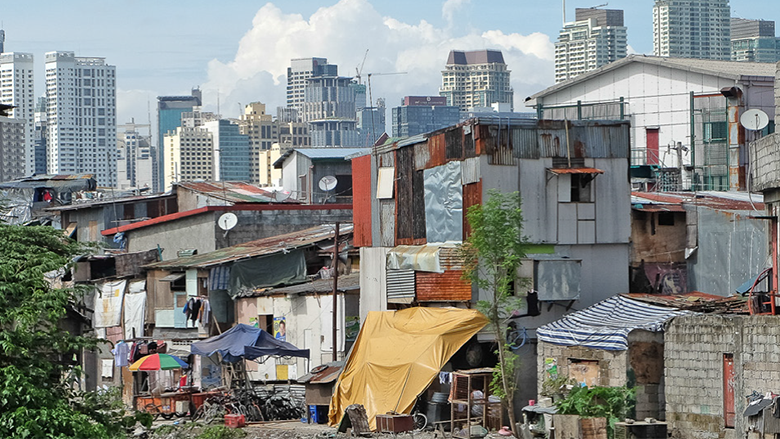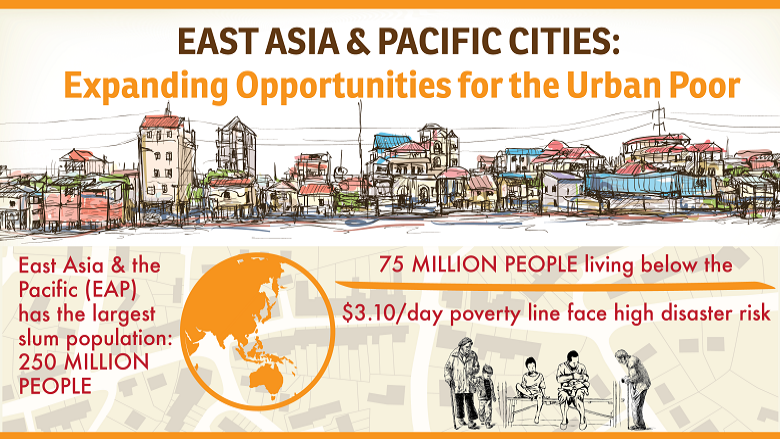Rapidly Urbanizing East Asia Pacific
- Cities across East Asia and the Pacific are not delivering infrastructure, jobs, and services at a pace as rapid as urban development, leading to widening inequalities which may hamper economic growth and lead to social divisions, says a new World Bank report called Expanding Opportunities for the Urban Poor.
- East Asia and the Pacific is the world’s most rapidly urbanizing region, with an average annual urbanization rate of 3 percent.
- By 2018, half of the region’s population will be urban – more than 1.2 billion people in all, or one-third of the world’s urban population.
- City-led growth has helped life 655 million people out of poverty in the last two decades.
Need for More Infrastructure, Jobs, and Social Protection
- But the region also has the world’s largest slum population: 250 million people with poor-quality housing, limited access to basic services, and at risk to hazards such as flooding.
- Failure to expand opportunities for the urban poor impacts the countries’ growth potential. In high-income countries, such as Japan and Korea, inclusive urbanization created the space for higher economic growth.
- Throughout the 1970s and 1980s, Singapore’s economy grew at an average of 8 percent annually, thanks to effective infrastructure, affordable housing, and social services.
- Three countries account for the bulk of the region’s urban poor: China, Indonesia, and the Philippines. That’s 75 million people in the region living with less than US$3.10 a day.
- Amongst the challenges faced by the poor is the lack of access to jobs, public transport and other infrastructure, and affordable housing.
- In Ulaanbaatar, Mongolia, low-income commuters can spend as much as 24 to 36 percent of their monthly expenses on bus fare.
- In Indonesia and the Philippines, 27 percent and 21 percent of the urban population, respectively, have no access to effective sanitation facilities.
- Slum residents are also more at risk to disasters, as the communities are often in low-lying flood-prone areas.
Multi-dimensional approach to planning
- The report encourages city governments to have a multi-dimensional approach to planning, incorporating aspects of economic, spatial, and social inclusion to foster economic growth and reduce poverty.
- Although 6 out of the world’s 10 mega-cities are in East Asia, urban poverty is more prevalent in secondary cities, which are growing in importance; as of 2010, small and medium cities account for a quarter of all cities in the region.
- The report recommends ten guiding policy principles that can be adapted to specific circumstances. They include:
- Connecting the urban poor with job markets;
- Investing in integrated urban planning; ensuring affordable land and housing;
- Recognizing the rights of all citizens to the city; Targeting marginalized sub-groups among the urban poor;
- Strengthening local governance and embracing citizen engagement;
- Investing in better data and information systems, for evidence-based policy making.
Some examples of successful programs:
a) Cash transfer programs: Urban Di Bao program in China; Pantawid Pamilya conditional cash transfer program in the Philippines.
b) Community upgrading programs: Slum upgrading program in Indonesia, which has provided improved water supply, drainage, road paving, solid waste services; micro-finance programs in Vietnam, which has enabled residents to invest in upgrades for their homes.
c) Transport programs: one in Northeast China incorporates the needs of low-income residents, largely pedestrians, and the disabled in the design of bus stops, intersections, sidewalks.

